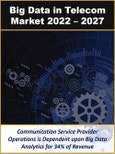Communication Service Provider Operations is Dependent upon Big Data Analytics for 34% of Revenue
Speak directly to the analyst to clarify any post sales queries you may have.
This report provides an assessment of the global structured data, big data and telecom analytics markets, including a study of the business drivers, application use cases, vendor landscape, value chain analysis, case studies and a quantitative assessment of the industry from 2022 to 2027.
Select Report Findings:
- Leading carriers are merging structured and unstructured data sources to obtain new information and insights
- Communication service provider operations is dependent upon big data analytics solutions for up to 34% of all carrier revenue
- Managed service providers in the big data analytics space offering data and insights as a service to carriers rely primarily upon cloud-based solutions
- The fastest growing component is the combination of AI and IoT data, which represents a merging of raw data derived from automation and AI-powered advanced analytics
Big data tools help communications service providers gain deeper insights into customer behavior, including usage patterns, preferences, and interests. While hard to derive quick and meaningful insights, big data solutions provide carrier insights into relationships, family, work patterns and location. This is increasingly achieved in real-time using both structured and unstructured data.
The term big data refers to a massive volume of both structured and unstructured data that is so large that it is difficult to process using traditional database and software techniques. While the presence of such datasets is not something new, the past few years have witnessed immense commercial investments in solutions that address the processing and analysis of big data.
Big data opens a vast array of applications and opportunities in multiple vertical sectors including not limited to retail and hospitality, media, utilities, financial services, healthcare and pharmaceutical, government and homeland security and the emerging industrial internet vertical. With access to vast amounts of datasets, telecom companies are also turning out to be major proponents of the big data movement. Big data technologies offer a multitude of benefits to network operators which include improving subscriber experience, building and maintaining smarter networks, reducing churn and even the generation of new revenue streams.
Big data and analytics have emerged as a potential source of revenue for telecom operators, at a time when carriers have been feeling the pressure to generate new sources of revenue. One of those sources comes from their ability to mine the huge amount of data they generate or have access to in both their customer base and their networks. The two have emerged as the tools to help analyze and manage this information. There are now many analytical and intelligence tools that enable mobile operators to understand customer and network behavior.
Communications service providers have a rich stream of data, especially those that offer telephony, TV and Internet services, the triple play operators. The many sources of data is an advantage for telecom companies, but if they want to monetize that data and derive meaningful, actionable analytics it could be challenging due to the complexities of correlation, prediction, and the massive volumes of data from different sources.
Big data helps telecom providers to get deeper insights into customer behavior, their service usage patterns, preferences, and interests. While hard to derive quick and meaningful insights, big data gives telecom companies an idea of relationships, family, work patterns and accurate location data among others. The publisher of this report believes that this will optimally be performed in real-time using both structured and unstructured data.
Prior to leveraging big data analytics solutions, communications service provider ‘raw data’ represents unprocessed and uncategorized content that flows across the network, and ‘meta-data’, which is the data describing the properties, sources, costs, etc. relating to the content. In terms of data types, carrier data can be divided into two broad categories as structured and unstructured data. The blending of the two provide particularly helpful insights in terms of network and service optimization, cost reduction, and generation of new insights and information.
With the purchase of this report at the Multi-user License or greater level, you will have access to one hour with an expert analyst who will help you link key findings in the report to the business issues you're addressing. This will need to be used within three months of purchase.
This report also includes a complimentary Excel file with data from the report for purchasers at the Site License or greater level.
Table of Contents
1.0 Executive Summary
Companies Mentioned
- Accenture
- Amazon
- Apache Software Foundation
- APTEAN (Formerly CDC Software)
- Cisco Systems
- Cloudera
- Dell EMC
- ElectrifAI (formerly Opera Solutions)
- GoodData Corporation
- Google (Alphabet)
- Guavus (Thales Group)
- Hitachi Data Systems
- Hortonworks
- HPE
- IBM
- Informatica
- Intel
- Jaspersoft (TIBCO)
- Microsoft
- MongoDB (Formerly 10Gen)
- MU Sigma
- Netapp
- Oracle
- Pentaho
- Platfora (Workday)
- Qliktech
- Rackspace Technology
- Revolution Analytics (Microsoft)
- Salesforce
- SAP
- SAS Institute
- Sisense
- Splunk
- Sqrrl Data
- Supermicro
- Tableau Software
- Teradata
- Tidemark (Insight Software)
- VMware
Methodology

LOADING...








